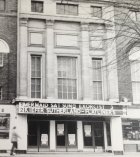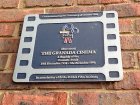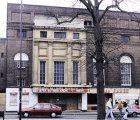Bedford
Cinema History
Places > Bedford > Cinemas > Bedford Cinema History Project
The Granada and Granada 2 Cinema
5-9 St Peter's Street, Bedford
Home | Granada | Sources | Images
The Granada Cinema
 By the early nineteen-thirties, there were four smallish cinemas in Bedford,
the Empire, the
Plaza, the
Picturedrome and the
Palace.
By the end of 1934, the thoroughly modern and luxurious 1750 seat Granada had
been constructed in record time in St Peter’s Street, Bedford. The Bedfordshire
Times of 14th December 1934 dedicated several columns to the full prospectus of
Granada (Bedford) Limited in which the share capital of £50,000 necessary to
float the new company was offered as 30,000 6% Cumulative Preference Shares and
20,000 Ordinary Shares, all of £1. Directors included Sydney and Cecil Bernstein
(The Bernstein Theatres Ltd.), Ernest Blake (Blake Bros. Theatres Ltd.), Sir
Thomas Keens (B. Laporte Ltd.) and Cecil Tingey (John Bull & Co.). These
indicated a mix of London professionalism and local business interests. It is
revealing to see the connection with the Bernsteins and the chain of nationwide
‘Granada’ and ‘Plaza’ picture houses bringing some London sophistication to the
activities of the redoubtable
Blake family.
By the early nineteen-thirties, there were four smallish cinemas in Bedford,
the Empire, the
Plaza, the
Picturedrome and the
Palace.
By the end of 1934, the thoroughly modern and luxurious 1750 seat Granada had
been constructed in record time in St Peter’s Street, Bedford. The Bedfordshire
Times of 14th December 1934 dedicated several columns to the full prospectus of
Granada (Bedford) Limited in which the share capital of £50,000 necessary to
float the new company was offered as 30,000 6% Cumulative Preference Shares and
20,000 Ordinary Shares, all of £1. Directors included Sydney and Cecil Bernstein
(The Bernstein Theatres Ltd.), Ernest Blake (Blake Bros. Theatres Ltd.), Sir
Thomas Keens (B. Laporte Ltd.) and Cecil Tingey (John Bull & Co.). These
indicated a mix of London professionalism and local business interests. It is
revealing to see the connection with the Bernsteins and the chain of nationwide
‘Granada’ and ‘Plaza’ picture houses bringing some London sophistication to the
activities of the redoubtable
Blake family.
The objects in the Memorandum of Association were:
1)'To erect a high-class Modern Super Cinema Theatre, with seating and standing capacity of approximately 1,750…in a manner comparable with the best cinema theatres in the country….with a frontage to St Peter’s Street of about 120 feet…
2)To take on lease, two existing Cinema Theatres (the Empire and the Palace)
3)To manage the three cinemas in conjunction with each other’.
The building of the theatre, shops, café and kiosk was to be carried out by
Bovis Ltd, with a completion date of 17th December [1934]. The prospectus set
out in some detail, the layout, construction and equipping of the building:
ventilation by the Plenum system, believed to be the ‘most hygienic and
satisfactory system yet devised’ and ‘faithful and realistic reproduction of
sound’ by ’The Western Electric Wide Range Reproducing System. The cinema would
be equipped with an eight rank Wurlitzer cinema organ (a three manual console on
a rising platform), plus a ‘Phantom’ grand piano on stage. The prospectus
reveals that the stage was intended to be added later, complete with dressing
rooms etc. if required for presentation of plays.
The site would include a café-restaurant with separate entrance from St Peter’s
Street, to seat approximately 150 patrons and would be run by local grocers Dudeney and Johnson, who already traded in the High Street. At the rear of the building, in Lurke Street,
a small car park would be provided. Mentioned too were 4 lock up shops and a
kiosk which completed the frontage on St Peter’s for lease to various tenants,
contributing some £600 per annum in rents. The whole project including the shops
and kiosk cost £48,750.
Ernest Blake and Bernsteins had put Bedford on the map. This building designed
by London Architects Benslyn and Morrison with interiors based on designs
created by Theodore Komisjarevsky was a long way ahead of other picture houses in
planning, equipment and modern technology and would continue to be so for the
rest of its 55 years.
The official opening took place on Saturday 15th December 1934 with the Band
of His Majesty’s Scots Guards in attendance. The audience included members and
officials of the Bedford Town Council, the County Council and chairmen of the
nearby Rural District Councils, together with ‘many leading town and county
people’. Mr Noel Hobart, previously at the Granada Cinema Tooting, had been
appointed manager. A packed programme was selected for the launch, beginning
with an opening ceremony introduced by Lord Ampthill followed by a screen
novelty, news in sound, a Laurel and Hardy comedy, The Private Life of Oliver the
Eighth, an organ recital by Harold Betts and a Metro-Goldwyn-Mayer picture
starring William Powell and Myrna Loy, The Thin Man. This programme was also
shown for the week of 17th December 1934. Granada pulled out all the stops in
marketing its new cinema, issuing the all Hollywood star programmes for the
following three weeks. There were continuous performances from 2.00pm daily and
adult tickets were priced at 9d and 1/3d for the stalls, circle, 1/6d and lodges
2/- and 2/6d.
The Granada was launched with considerable publicity locally and nationally.
Promotions listed all the novel features: a café/restaurant, the mighty
Wurlitzer organ, a modern ventilation system, talkie projection, earphones for
the deaf, a free cloakroom, public call box and a car park. Gratuities were
described as embarrassing and therefore not to be expected or accepted by the
staff. In keeping with the Bernstein philosophy, the experience of going to the
Granada was more than just seeing a film.
The Ideal Kinema and Studio, a supplement to Kinematograph
Weekly 17th January 1935, extolled the architectural and decorative detail
and in Architecture Illustrated March 1935, there are images showing
details of the exterior and interior. A publicity brochure published for the
opening ceremony gave extensive statistics about the impressive number of
bricks, miles of cable and yards of carpet used in the cinema and highlighted
the fact that the build was accomplished 3 months ahead of schedule, gave work
to 190 local men and that most suppliers were from Britain and its Empire. Local
businesses were proud to be associated with the new glamorous venue. The Bedford
Corporation Electricity Service claiming that without its services ‘this wonder
theatre would not be possible’. Over 40 people were employed, front of house
staff wearing the Granada uniform of royal blue with maroon and gold trim.
From the enthusiastic launch in December 1934 to its eventual demise in 1991, the Granada was not only a cinema screen but also a venue
for stage acts and concerts. Organ concerts were broadcast by the BBC, the first
took place on March 13th 1936 and many of the best known organists played at the
Granada. During the Second World War, in July 1943 the cinema hosted
Holidays-at-home concerts on Sunday afternoons. One featured the ten and a half
year old ‘phenomenon Miss Petula Clarke who took command of the vast stage for
ten minutes giving impressions of various accents. Sunday opening for cinemas
was a perennial battle. Earlier in 1940 the Bedfordshire County Council
Stage
Plays and Cinematograph Licensing Committee granted permission to the
Granada and Plaza cinemas to open on Sundays between 5.00pm and 10.30pm to show
films with certain restrictions. Between 5-5.30 music only was allowed.
Cinemascope, with stereophonic sound was introduced in October 1954 and then in
1968 extensive alterations were made to the cinema when the second largest
screen in the country (over three times larger than the original) was installed
to show the new generation of 70mm films. Six rows of seats were removed, the
organ relocated and new sound technology introduced. Seat prices went up! The
first 70mm film was Dr Doolittle in July 1968. There was a gala opening
attended by the Mayor and local celebrity singer Cleo (now Dame) Lane. Birds and
a monkey were borrowed from a local zoo. That same year, Granada Theatres
Limited took over the cinema.
Granada managers in the 60s were keen to market new films with ingenious
promotions. Events included a turkey plucking contest for Crooks in Cloisters
with an appearance by actor Melvyn Hayes. There was a sheep shearing contest
on stage in 1965, to accompany a Western - one animal escaped into the stalls. A
big campaign was arranged in the same year for the film of Mary Poppins
with live penguins in a pool in the foyer, a chimp’s tea party at the Saturday
children’s matinee and a fashion parade in the restaurant. Usherette Margaret
Davies swam in a 1000 gallon fish tank in the foyer to promote the James Bond
film Thunderball. Other stunts included staff appearing in ape skins in
the Market Square overnight to promote Planet of the Apes. To publicise
The Sand Pebble, staff disguised as coolies pulled a rickshaw from London
to Bedford. Local businesses were happy to promote forthcoming films where there
was a particular tie-in.
Like the Empire, the Granada ran children’s matinees. By the early 60s, 1200
were entertained on Saturday mornings with stage shows, films, organ recitals
and competitions. You could become a Granadier or an Empire Ranger with treats
on your birthday.
During the 1950s and 60s there were regular pop stage shows featuring leading stars of the era. Notably in February 1963, Helen Shapiro was supported by a new group called the Beatles. Dave Allen compèred. The following year, the Granada staged a specially written pantomime Once Upon a Fairy Tale starring Millie. By 1968 the ‘beat boom’ was on its way out and many of the acts had made too many appearances! By now the cinema was owned by Granada Theatres Ltd.
Eventually the stage shows, promotional stunts and the conversion of the restaurant into Granada 2 seating 209 patrons, in July 1974 were not enough to compete with changing tastes, not least from bigger and better televisions in the home. Audience numbers were falling. The Granada management denied having problems but did admit that holiday time showings and certain blockbuster films were becoming the main attractions.
In the 1980s articles started appearing in the local newspapers about plans to develop and change the Granada. An application for a bingo licence had been fought off after objections from Mecca and Ladbrokes, the Bedfordshire Journal reported in December 1982. In June 1986, the Bedfordshire Times noted that an application for the Granada to develop as a night club, a bar and two cinema screens, had been denied after objections from Chris Sweeting, a local night club owner. That same year yet another bingo licence application was rejected. Then at the beginning of 1989, the Bedford Herald announced that the Granada had been sold for more than £1 million but that the new owners Simkel Developments and City and County Developments had offered to keep the cinema functioning, programmed by Cannon until a new cinema opened. By April 1989, Bedfordshire on Sunday was reporting on secret negotiations by North Bedfordshire Borough Council to acquire the Granada site from the developers. The council had plans to convert the building into a theatre. The discussions came to nothing and when the vote was taken by the council in August 1989, by a narrow majority, the owners were given permission to demolish the cinema and develop the site.
The final screening at the Granada was Exorcist 3. The cinema closed its doors on December 2nd 1990 and the contents of the cinema were auctioned: the Wurlitzer organ had previously been sold in the late 1970s. Some items were recycled: 300 of the seats were sold to the Bowen West Theatre. Local businessman Brian Howard bid successfully for the massive 23 foot foyer chandelier. After demolition, the site was left as an unsurfaced car park for some years until a supermarket chain took it over. It is slightly bizarre nowadays to enter this new building and remember how vast the Granada seemed, even though the store occupies almost the same footprint.
 During
its existence, the Granada meant different things to different people: articles
regretting its loss and questioning why it could not have been saved appeared
for some years after it had gone. Money for development was beginning to be
short in the 1990s: there appeared to be no other viable use for a building
designed as a cinema. Sadly this cinema was not then deemed to be worthy of
being listed. Even the façade was not able to be preserved of this vibrant,
glamorous and very human construction. Now all that survives is a plaque in St
Peter's Street, ‘Here
stood the Granada Cinema, a flagship of the Granada Circuit 15th December 1934 -
5th December 1990’.
During
its existence, the Granada meant different things to different people: articles
regretting its loss and questioning why it could not have been saved appeared
for some years after it had gone. Money for development was beginning to be
short in the 1990s: there appeared to be no other viable use for a building
designed as a cinema. Sadly this cinema was not then deemed to be worthy of
being listed. Even the façade was not able to be preserved of this vibrant,
glamorous and very human construction. Now all that survives is a plaque in St
Peter's Street, ‘Here
stood the Granada Cinema, a flagship of the Granada Circuit 15th December 1934 -
5th December 1990’.
© Graham Trundley
2013
Sources
Books and Magazines (available at Bedford Library)
- The Final Curtain - the death knell tolls for Bedfordshire's Granada, Bedfordshire Life, March 1989 p.12
- Catalogue of The art deco furnishings, equipment, fixtures and fittings of the St Peter's Street cinema Bedford. Sale by tender by Wilson Peacock (viewing Tuesday 11th and Saturday 15th December 1990).
- David Simpson. Granada Management 2- Bedford, The Mercia Bioscope Nov. 2006 pp.1-12
- John D. Squires. Bedford Cinema's Golden Jubilee [Granada], Northamptonshire and Bedfordshire Life, Dec. 1984 pp.26-28
- John D. Squires. Fifty Years of the Granada Cinema, Bedford, Bedfordshire Magazine, vol. 19 pp.275-278
- R. Wildman. Death of a Supercinema: the Granada Bedford, Bedfordshire Magazine, vol. 23 pp.39-40 (Summer 1991)
Newspapers (available at Bedford Library)
- Local newspaper and magazine cuttings, Bedford: Cinemas, at Bedford Library
- Doug Bowker. The Last Picture Show, Ampthill and Flitwick Times, 13th December 1984 p.7
- The Granada: arrangements for the opening ceremony, Bedfordshire Times and Independent, Friday 14th December 1934 p.13
- Granada Opened, Bedfordshire Times and Independent, Friday 21st December 1934 p.10
Images
Page last updated: 25th February 2014






